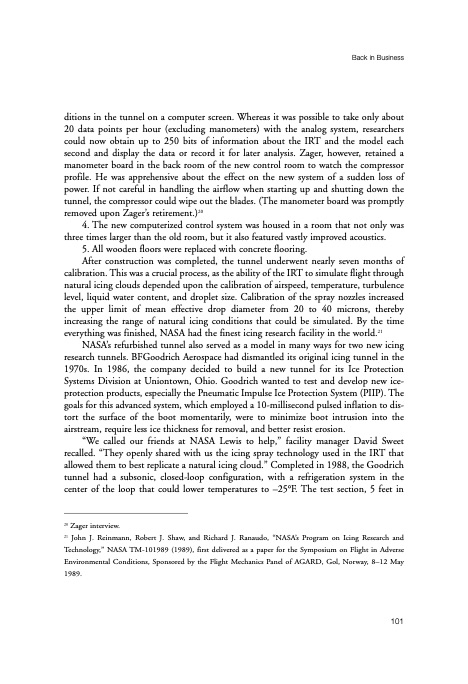
PDF Publication Title:
Text from PDF Page: 113
ditions in the tunnel on a computer screen. Whereas it was possible to take only about 20 data points per hour (excluding manometers) with the analog system, researchers could now obtain up to 250 bits of information about the IRT and the model each second and display the data or record it for later analysis. Zager, however, retained a manometer board in the back room of the new control room to watch the compressor profile. He was apprehensive about the effect on the new system of a sudden loss of power. If not careful in handling the airflow when starting up and shutting down the tunnel, the compressor could wipe out the blades. (The manometer board was promptly removed upon Zager’s retirement.)20 4. The new computerized control system was housed in a room that not only was three times larger than the old room, but it also featured vastly improved acoustics. 5. All wooden floors were replaced with concrete flooring. After construction was completed, the tunnel underwent nearly seven months of calibration. This was a crucial process, as the ability of the IRT to simulate flight through natural icing clouds depended upon the calibration of airspeed, temperature, turbulence level, liquid water content, and droplet size. Calibration of the spray nozzles increased the upper limit of mean effective drop diameter from 20 to 40 microns, thereby increasing the range of natural icing conditions that could be simulated. By the time everything was finished, NASA had the finest icing research facility in the world.21 NASA’s refurbished tunnel also served as a model in many ways for two new icing research tunnels. BFGoodrich Aerospace had dismantled its original icing tunnel in the 1970s. In 1986, the company decided to build a new tunnel for its Ice Protection Systems Division at Uniontown, Ohio. Goodrich wanted to test and develop new ice- protection products, especially the Pneumatic Impulse Ice Protection System (PIIP). The goals for this advanced system, which employed a 10-millisecond pulsed inflation to dis- tort the surface of the boot momentarily, were to minimize boot intrusion into the airstream, require less ice thickness for removal, and better resist erosion. “We called our friends at NASA Lewis to help,” facility manager David Sweet recalled. “They openly shared with us the icing spray technology used in the IRT that allowed them to best replicate a natural icing cloud.” Completed in 1988, the Goodrich tunnel had a subsonic, closed-loop configuration, with a refrigeration system in the center of the loop that could lower temperatures to –25°F. The test section, 5 feet in Back in Business 20 Zager interview. 21 John J. Reinmann, Robert J. Shaw, and Richard J. Ranaudo, “NASA’s Program on Icing Research and Technology,” NASA TM-101989 (1989), first delivered as a paper for the Symposium on Flight in Adverse Environmental Conditions, Sponsored by the Flight Mechanics Panel of AGARD, Gol, Norway, 8–12 May 1989. 101PDF Image | History of NASA Icing Research Tunnel

PDF Search Title:
History of NASA Icing Research TunnelOriginal File Name Searched:
sp4226.pdfDIY PDF Search: Google It | Yahoo | Bing
NFT (Non Fungible Token): Buy our tech, design, development or system NFT and become part of our tech NFT network... More Info
IT XR Project Redstone NFT Available for Sale: NFT for high tech turbine design with one part 3D printed counter-rotating energy turbine. Be part of the future with this NFT. Can be bought and sold but only one design NFT exists. Royalties go to the developer (Infinity) to keep enhancing design and applications... More Info
Infinity Turbine IT XR Project Redstone Design: NFT for sale... NFT for high tech turbine design with one part 3D printed counter-rotating energy turbine. Includes all rights to this turbine design, including license for Fluid Handling Block I and II for the turbine assembly and housing. The NFT includes the blueprints (cad/cam), revenue streams, and all future development of the IT XR Project Redstone... More Info
Infinity Turbine ROT Radial Outflow Turbine 24 Design and Worldwide Rights: NFT for sale... NFT for the ROT 24 energy turbine. Be part of the future with this NFT. This design can be bought and sold but only one design NFT exists. You may manufacture the unit, or get the revenues from its sale from Infinity Turbine. Royalties go to the developer (Infinity) to keep enhancing design and applications... More Info
Infinity Supercritical CO2 10 Liter Extractor Design and Worldwide Rights: The Infinity Supercritical 10L CO2 extractor is for botanical oil extraction, which is rich in terpenes and can produce shelf ready full spectrum oil. With over 5 years of development, this industry leader mature extractor machine has been sold since 2015 and is part of many profitable businesses. The process can also be used for electrowinning, e-waste recycling, and lithium battery recycling, gold mining electronic wastes, precious metals. CO2 can also be used in a reverse fuel cell with nafion to make a gas-to-liquids fuel, such as methanol, ethanol and butanol or ethylene. Supercritical CO2 has also been used for treating nafion to make it more effective catalyst. This NFT is for the purchase of worldwide rights which includes the design. More Info
NFT (Non Fungible Token): Buy our tech, design, development or system NFT and become part of our tech NFT network... More Info
Infinity Turbine Products: Special for this month, any plans are $10,000 for complete Cad/Cam blueprints. License is for one build. Try before you buy a production license. May pay by Bitcoin or other Crypto. Products Page... More Info
| CONTACT TEL: 608-238-6001 Email: greg@infinityturbine.com | RSS | AMP |